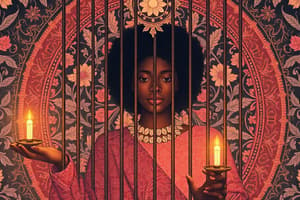Podcast
Questions and Answers
What are the consequences of the missing million black men?
What are the consequences of the missing million black men?
70% professional black women not married, gender gaps of 26% (37% in NYC), more blacks in prison parole than slavery in 1850, black kids less likely to have 2 parents now than in slavery, more blacks unable to vote now than in 1870, 37% more black women than men.
What are the 3 stages of mass incarceration due to structural racism?
What are the 3 stages of mass incarceration due to structural racism?
- Round up, case incentives, stop and search, racial profiling; 2. Prison, load up, plea bargaining, mandatory sentencing; 3. Civil penalties, housing, jobs, voting, juries.
What is one of the main points of the book?
What is one of the main points of the book?
The evolution in the US from a racial caste system based on exploitation (slavery), to one based on subordination (Jim Crow), to one defined by marginalization (mass incarceration).
How has the war on drugs affected Chicago?
How has the war on drugs affected Chicago?
How is mass incarceration as a racial caste system similar to Jim Crow?
How is mass incarceration as a racial caste system similar to Jim Crow?
How is mass incarceration as a racial caste system different from Jim Crow?
How is mass incarceration as a racial caste system different from Jim Crow?
How is the war on drugs different from the war on drinking and driving?
How is the war on drugs different from the war on drinking and driving?
Flashcards are hidden until you start studying
Study Notes
Missing Black Men and Consequences
- Approximately 70% of professional black women are unmarried, revealing significant gender gaps.
- The gap in marriage rates is 26% overall, increasing to 37% in New York City.
- The number of black individuals on parole exceeds the number of enslaved blacks in 1850.
- Black children are less likely to grow up with both parents now compared to during the slavery era.
- There are more disenfranchised black voters today than in 1870.
- About 37% more black women than men highlight a demographic imbalance.
Three Stages of Mass Incarceration and Structural Racism
- First stage involves the rounding up of individuals through methods like stop and search, racial profiling, and system integration.
- Second stage consists of imprisonment dynamics including plea bargaining and mandatory sentencing, with harsher penalties for crack versus cocaine offenses.
- Third stage encompasses resulting civil penalties affecting housing, employment, voting rights, and jury participation, disproportionately impacting black individuals.
Main Point of the Book
- The evolution of the US racial caste system transitioned from exploitation (slavery) to subordination (Jim Crow) and now to marginalization (mass incarceration).
Impact of the War on Drugs in Chicago
- Approximately 90% of prison inmates are black, correlating with a criminal record in 55% of adult men.
- 70% of felony convictions are for low-level Class D drug possession.
- By 2001, there were 20,000 more black men incarcerated than enrolled in universities.
Similarities Between Mass Incarceration and Jim Crow
- Both systems exploit and manipulate poor black and white communities as a divisive tactic.
- Sentencing for crack offenses is harsher than for cocaine, perpetuating racial inequities.
- Being black has become synonymous with being a criminal second-class citizen, paralleling the disenfranchisement tactics used under Jim Crow.
Differences Between Mass Incarceration and Jim Crow
- Jim Crow laws deployed explicit racism, while mass incarceration relies on implicit racial biases.
- Mass incarceration affects poor whites as well, diverging from the more explicit racial segregation of Jim Crow.
- The current system obscures racial issues, making it less apparent, unlike the overt segregation in the Jim Crow era.
- Black communities exhibit varied attitudes towards law enforcement driven by safety concerns, leading to internal divisions.
Contrast Between the War on Drugs and the War on Drunk Driving
- A higher prevalence of drunk driving occurs among white individuals, resulting in significantly more fatalities than drug-related incidents.
- Despite the severity of alcohol-related problems, there has not been a comparable crackdown on drunk driving.
- White men constitute 78% of those arrested for drunk driving, highlighting racial disparities in law enforcement penalties.
Studying That Suits You
Use AI to generate personalized quizzes and flashcards to suit your learning preferences.




